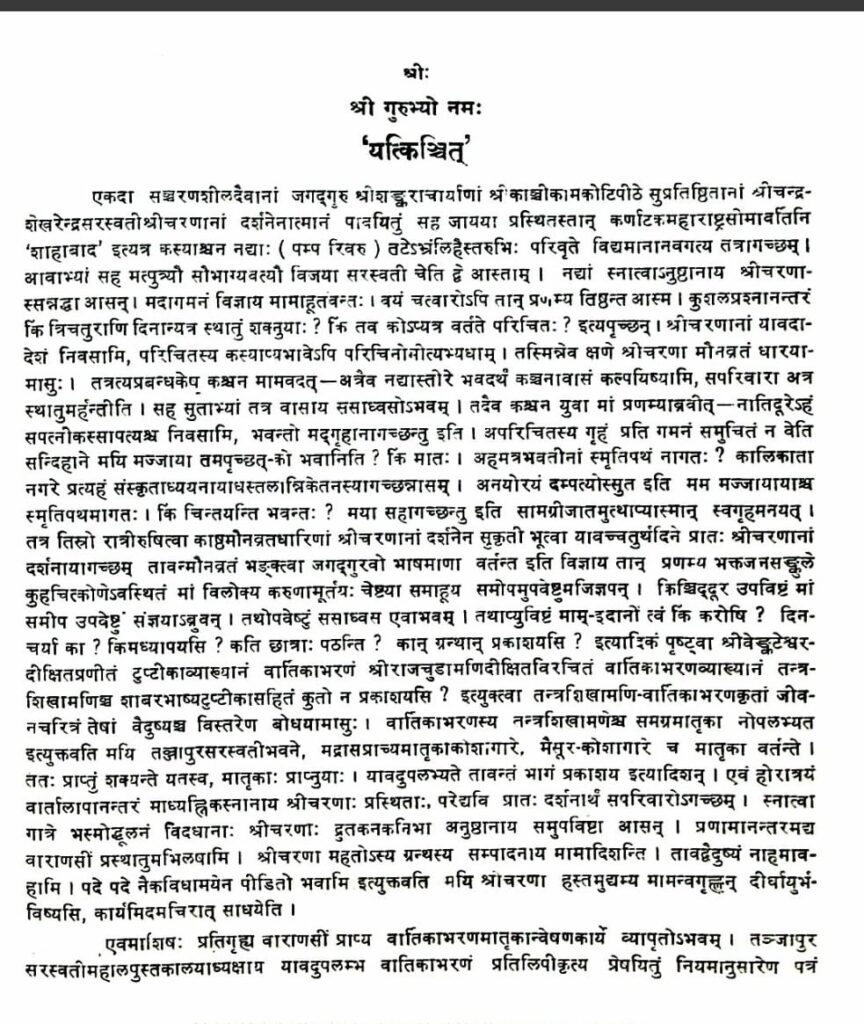Shankarite Institutions have been at the forefront of patronising and encouraging the publication of rare shastra granthas and scholars in all parts of the country. We have seen earlier about the publication of Shivarahasyam Manuscripts by the North and South Indian scholars in 1932 & 1934 and the interactions of Tarkaratna Panchanana Bhattacharya of Bengal in Kashi.
Another such account of Kanchi-Kashi Sambandha is the account of Mimamsakesari Vidyavachaspati Mahamahopadhyaya Padmabhusana Pandit P. N. Pattabhirama Shastriji. He was born in 1908 in Palasur village near Kanchipuram, initially educated at Tirupati and later in Varanasi under M.M. Chinnaswami Shastri. From there he went to Kashi and served at Banaras Hindu University. Pandit Madan Mohan Malaviya later recommended his appointment as Principal of Maharaja Sanskrit College, Jaipur. His dedicated mastery of the sastric tradition of Bharatam and his writings, lectures and editions on Mimamsa remain as evidence of his work.
The All-India Kashiraj Trust was established in 1951 and its silver jubilee was celebrated on 24th October 1981. The recods of the proceedings started with a mangalacharana by Shri Ganeshvara Dravid and Shri Pattabhirama Shastri read out a sandesha from Shri Chandrashekharendra Saraswati Swamigal, the 68th Acharya of Shri Kanchi Kamakoti Pitham that was specially sent for the occasion. This is published in the summary of the activities of the Kashiraj Trust in 1982
Pt. Pattabhirama Shastri’s disciple Pt. Dr.Mandana Mishraji writes in his general editor’s preface of the edition of the Lal Bahadur Shastri Kendiya VidyaPith 1984 wries in his introduction to “Shabara Bhashya with the Tuptika Varttikabharana, Tantrashikhamani and Bhashya Sandarbha Yojini” says that it was only due to the anugraha of Shri Kanchi Kamakoti Acharya that his guru Shri Pattabhirama Shastri was able to do this work and seeks their continued blessings for the good health and strength for Shastri to complete this work.
The Tuptika is written by Shri Venkateshvara Dikshita, the architect of the 72-mela system and the son of Advaita Vidyacharya Govinda Dikshitar. The relationship of the matrilineal side of this Govinda Dikshita family to the purvashrama families of Shri Kanchi Kamakoti Pitham is well-known. The Tantrashikhamani is written by Shri Rajachudamani Dikshita, the youngest son of Shri Ratnakheta Dikshitar and also a student of Shri Nilakantha Dikshitar. Rajachudamani Dikshita was a gifted writer of kavya and the author of Shankarabhyudaya, a literary work on Shankaracharya which traces his birth to His siddhi in Kanchipuram.
The story behind this publication is narrated by Pandit Pattabhirama Shastri in the introduction titled “Yatkinchit”. Shastriji says as follows:
“Once I went to Shahabad near the banks of Pampa river in Karnataka to have darshana of the “walking God”, Shri Chandrashekarendra Saraswati Shricharana, of Shri Kanchi Kamakoti Pitham established by Shri Jagadguru Adishankaracharya with my spouse. My two daughters were also with me. Shricharana was getting ready to have his snana. Knowing that I had come, he beckoned me. All of us went towards Him. He asked me if I can stay there for 3-4 days and if I knew someone near by. I responded that I will stay as long as Shricharana wishes and that I will get to know someone who lives around the area. Then someone said they will make arrangements for my stay with family hear near the banks.”
Then a young man who they knew from Kolkata introduced himself to them and took them to his home for three days. Then for three days we had the fortune of darshana of Shricharana who was in the state of Kashtamauna for three days. On the fourth day having learnt that the Jagadguru completed His maunavrata and was speaking, we went. The Karunamurti looked at us and beckoned us. He asked us what our daily activities were and how many students were studying and what I was teaching and what I was publishing. Then he asked me why I had not yet edited and published the TupTika of Shri Venkateshvara Dikshita and the Tantrashikhamani of Shri Rajachudamani Dikshita.Then he detailed the lives of the two granthakarthas. When I replied that that the manuscripts of these two were not available to me in full, He said that manuscripts of these works will be available in the Tanjavur Sarasvati Mahal and Government Oriental Manuscripts Library, Madras and in Mysore Oriental Library and you may try and obtain the copies. Publish whatever you can find.”
Three hours went by in this conversation and thus instructed. Then Shricharana was getting ready for His anushthana and we sought His permission to go back to Varanashi and then mentioned that Shricharana has given ajna to publish this work but I fear that I don’t have the kind of vaidushyam and am afraid at each step I take”. Shricharana raised His hand blessed me and said “You will have a long life and take up this work at the earliest and complete it!”
Then he details the accounts of how he collected the various manuscripts from different locations and also found a copy from the collection of his teacher Chinnaswami Dikshitar and with prayers to Shricharana he began the laghu tika that accompnies this text and how this was published with the assistance of his student Mandana Mishra.
Panditaraja Pattabhirama Shastri was also the editor of Advaita Grantha Kosha. In the year 1946, Shri Shankaracharya of Shri Kanchi Kamakoti Mulamnaya Sarvajna Pitham expressed a desire that a comprehensive list of all manuscripts and books pertaining to Advaita be compiled and published. This was prepared by a disciple of Sri Ishtasiddhindra Saraswati Swami of the Upanishad Brahmendra Matha Kanchipuram and edited by Panditaraja Pattabhirama Shastri and was released in 1964.




